NOTES FROM OUR COVID-19 FUTURE IN AUSTRALIA – What Might Tourism Look Like?
In Australia we are now at the stage of the pandemic/epidemic where people are starting to think through the next stage. If we can keep numbers relatively low in the next few weeks, then the pressures will grow about relaxing the current restrictions. The result will be a combination of:
- Government decision making, which will be informed both by modelling and the results of what other countries do.
- The reactions of people to the change. This will vary in the light of what individuals have experienced over the last few weeks. This will also be influenced by social, demographic, and cultural differences in different countries and regions.
The Basic Scenarios
To understand what might happen to tourism, we need to understand what might happen more generally.
There are three basic scenarios that we can use to think about what happens to tourism:
- The Virus Elimination Scenario +/- New Zealand. Where we accidentally eliminate the virus with our restriction strategy (the Prime Minister is saying that they are not trying to do this, but I suspect it is certainly on the planning table). We will have a more detailed analysis of this scenario to release soon.
- A Low Level Well Controlled Epidemic that looks a little like South Korea does at the moment:
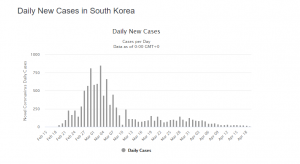
Source: https://www.worldometers.info/coronavirus/country/south-korea/
3/ A Wilder Ride. This one looks a little like the model for a rolling epidemic that the Imperial College in London looked at:

This is where successive waves of cases rise and fall as transmission increases when restrictions are removed and then reduce when restrictions are re-imposed.
The Key Drivers Inside the Scenarios
If we look at the key drivers of government policy and human behaviour in the overall community, then we need to think about the forces that drive transmission and the forces that drive higher mortality from cases.
In the case of transmission, then the following force field analysis is a good summary of what is at play. The red arrows indicate factors that increase transmission and the blue arrows indicate factors that reduce transmission.
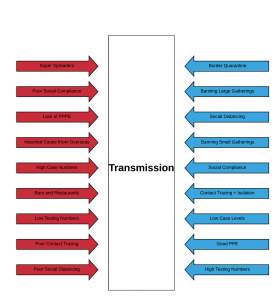
As stated by the Prime Minister in Australia on April 16th, the government strategy has been to reduce virus transmission for long enough to prepare our systems for a relaxation of restrictions. The key components of this preparation are:
- Increases in testing capacity.
- Increases in tracing capacity (this article from the ABC gives a good summary of the level of increase that is going on: https://www.abc.net.au/news/2020-04-16/meet-the-contact-tracers-fighting-coronavirus-in-australia/12151302 “Spread across six floors in a skyscraper in Melbourne’s CBD, a team of about 30 has become nearly 1,000”)
- Increasing levels of PPE
- Increased capacity of the healthcare system to deal with cases
In terms of restrictions, given that many cases have come from overseas travellers and that there have been demonstrated cases globally of super-spreader events and clusters in bars and medical facilities it is highly likely that a relaxation of restrictions will still include:
- Strong border controls on people entering the country.
- Bans on larger gatherings such as large conferences, sporting crowds.
- Restrictions on other gathering places such as cinemas, cafes, and shops that reduce the density of people in those spaces and spread them out.
This leaves the social compliance factors which may be problematic. Government restrictions and punishments for misbehaviour can only work for short periods unless there is significant cooperation from the majority of the community. Given that the wave of cases experienced in Italy, Spain, the United Kingdom and the USA has not arrived in Australia the motivations of people to keep responding to social distancing requests and instructions may wane quite quickly. The level of compliance may be increased by good communication, or more worryingly by a second wave of cases.
One exception to this will be older people. A force field analysis of what drives up mortalities looks like this:
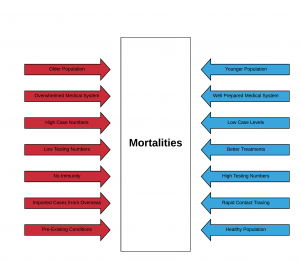
If we avoid really high case numbers overwhelming the medical system and have relatively high border controls, then the main risk for high mortality numbers is exposure of older people. This graph from South Korea puts this is stark relief:

Source: https://www.cdc.go.kr/board/board.es?mid=a30402000000&bid=0030)
South Korea has responded well to their to the outbreak. Their hospital systems have not been overwhelmed, and they and a modern health system. All of this combined means that their mortality figures are a best-case scenario. The high levels of mortality that are occurring in older people will have an effect on the willingness of older people to move about, and how they move about.
A subsection of the younger age groups, especially those with pre-existing conditions, will also have lower levels of mobility.
If we combine this all together, then I think that the overall picture is one of:
- High levels of testing and contact tracing so we know what is happening and are able to jump on it quickly.
- Strong border controls (and complete in the case of a virus elimination scenario).
- Bans on larger gatherings such as large conferences, sporting crowds.
- Restrictions on other gathering places such as cinemas, cafes, and shops that reduce the density of people in those spaces and spread them out.
- Reduce socialisation and mobility of a significant percentage of the population
So What About Tourism?
There are two key issues to look at here, the first is the economic nature of the tourism industry, the second is the likely behaviour of people.
The Economic Value of Tourism
There are a lot of numbers bandied about, but the main ones from Tourism Research Australia (https://www.tra.gov.au/economic-analysis/economic-value/national-tourism-satellite-account/national-tourism-satellite-account) are:
- International visitors spent A$39.1 billion in 2018/19, although that included A$7.9 billion in spending by students.
- Australian travellers going overseas spent A$58.3 billion in 2018/19.
- Australians travelling domestically spent $112.9 billion.
This leads to several conclusions:
- Tourism is very important to Australia’s economy.
- Loss of tourism expenditure due to travel restrictions is going to hit some economies very hard.
- International travel has a deficit of A$19.2 billion (and A$27 billion if you exclude student spending) billion with Australians spending more travelling overseas than visitors spend travelling here. So, if Australians cannot travel overseas, more money might be spent on domestic tourism. Of course, given economic impacts, people will have less money to spend overall.
Human Behaviour
If we think about the effects of the COVID-19 outbreak on domestic and international travel, then we can break it down into three key areas:
- Physical barriers to travel imposed by governments at national or regional levels.
- Confidence barriers as potential tourists worry about what might happen, especially internationally. People will be unsure of when quarantine barriers might be lifted, and even if they are lifted, uncertain if those barriers might be reinstated at any time. They will also be uncertain about their safety, and the reliance they can have on medical systems and insurance coverage. Safety issues will be particularly important to older travellers. Given the economic disruptions that have occurred and stories that people are seeing daily about possible airline and business failures, tourists will also be uncertain if a forward booking will be honoured.
- Economic barriers caused by the effects of the pandemic. Individuals may have lost their jobs, or be in fear of losing their jobs. Businesses will have lost money or had reduced profits. Individuals may have had their superannuation funds significantly damaged. All of these impacts will reduce their economic capacity and willingness to travel. Of course, at the same time, people in Australia who have had travel plans postponed may choose to spend money on a domestic trip that they would otherwise have not taken.
So, What do the Scenarios Look Like?
The Virus Elimination Scenario +/- New Zealand
In this scenario, we eliminate the virus in Australia and New Zealand and agree on complete border controls. This means no people coming into Australia and New Zealand for say 12-18 months except those travelling between Australia and New Zealand. This is because if you have no virus circulating in your country, then a test and quarantine system is almost certain to allow small numbers of infected people in. If you have no virus circulating in your country plus hardly any immunity in your population, then letting a few people in that are infected could start of a second wave epidemic. An alternative is to allow people in that have two positive antibody tests in a row 14 days apart. However, there are still questions about whether all people with antibodies are not infected. Any test and quarantine system is a public health response, not a hard and fast barrier.
In this scenario, domestic tourism could do quite well. People will be able to move around freely inside Australia and between Australian and New Zealand without being worried about the risk of contracting the virus. They would also be confident about booking holidays in advance. This means that people will be more likely to travel over longer distances and via planes. Ski fields will be able to open fully with share accommodation. People will not be scared about going out to bars and cafes. Money that would otherwise have been spent on international trips would be spent domestically. After long periods of restrictions, people would be very keen to get out and about.
A Low Level Well Controlled Epidemic
Australia has been very successful so far at containing COVID-19 as can be seen in the following graph (from: https://www.worldometers.info/coronavirus/country/australia/) :
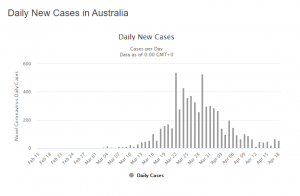
At April 18th, 2020 the confirmed case numbers were 6,586. Given that the number of new cases has been falling, that the majority of cases have been from returning travellers, and community transmission has been low, this figure is probably reasonably accurate. With this success comes a new challenge. Even if we assume that there are really four times the number of cases that is only 0.1% of the total population. That means 99.9% of the population still has no immunity. In epidemiological terms, that means that the situation on immunity is no different than six months ago. The population is basically 100% susceptible. What has changed is that we have many more sources of possible infection, both domestically and internationally. That makes us very vulnerable to the situation of a second wave epidemic if community transmission starts up again.
I think that this is unlikely. The government strategy has been to knock down the community transmission to give us breathing space to prepare for the next phase. That next phase appears to be driven around three factors:
- Increased testing and contact tracing capacity, so we have more knowledge about what is happening. This capacity gives us the ability to jump quickly on to emerging community transmission.
- Increased capacity of the healthcare system to respond.
- The need to relax some restrictions to allow economic activity to pick up again.
In turn, my view is that the thinking of governments will be driven by their recent experience, which is:
- Recognition of the innate susceptibility of the population.
- Their surprise at the behaviour of some people in response to social distancing requirements.
- The flouting of self-isolation rules by returning travellers. In a recent check by police in Victoria over 25% of returning travellers in self-isolation were found to be not adhering to that self-isolation (Coronavirus cases in Victoria grow as dozens of people are caught breaching self-isolationhttps://7news.com.au/lifestyle/health-wellbeing/coronavirus-cases-in-victoria-grow-as-dozens-of-people-are-caught-breaching-self-isolation-c-956272).
Therefore quite strong border controls are likely to be in place for sometime. These are likely to look something like the South Korean controls that were put in place when cases from Europe were rising:
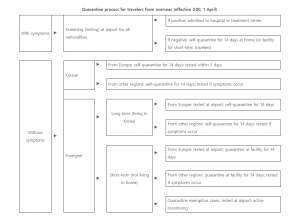
Source: https://www.cdc.go.kr/board/board.es?mid=a30402000000&bid=0030)
My view is that all travellers will be subject to test and quarantine in specified locations at their own cost.
Even if cases are kept low overall recent experience shows us the likely path forward. During the last ten days there has been a major outbreak in Northern Tasmania centred around two hospitals. The response has been to put 4000-5000 people into quarantine. There has also been an outbreak in an aged care facility in New South Wales. So, what we are likely to see is generally low numbers with flare-ups around the country which are quickly jumped on to stop a second wave starting.
What this means for tourism is :
- Hardly any international tourists given that most people will not come for a holiday to sit inside a quarantine hotel for 14 days.
- Hardly any Australians travelling overseas on holidays given that they will have to pay for two weeks quarantine when they return. This is on top of the levels of uncertainty around what might happen in the country or countries they plan to visit.
- Reasonable levels of uncertainty about booking holidays because of concern that the region they are travelling to maybe shut down before they travel or during their trip.
This leaves us with a picture of more Australians holidaying within Australia than historically. However, I believe that the visits will be of a shorter duration, and closer to home than previously for several reasons:
- Concern about flying and risking sitting next to someone else who may be infected.
- Concern about state border controls being reinstated before or during their trip.
- Concern about long-distance driving passing through many areas, increasing the chances of being caught in a restricted zone.
- Reduced inclination to spend up big on any single trip given the economic damage that has been done.
- Marketing programs exploiting these fears.
These factors will favour the states and regions with larger populations with less reliance on international and interstate tourism. So tourist destinations in Victoria will fare better than those in Northern Queensland who will lose both their international visitors and a large portion of interstate visitors.
Older people will be less likely to travel than the general population.
These factors will wane over time if things remain well controlled, and the economic pain is seen to be reducing.
The Wild Ride Scenario
In this scenario, despite strong national border controls a combination of pressure to open up the economy and less social compliance results in a series of larger-scale small outbreaks which results in stronger reinstatement of government restrictions. This dents the general confidence of the community as they realise that the virus cannot be contained as they thought. Increased imposition of shutdowns increase the level of uncertainty about travelling. Longer economic disruption curtails people’s capacity to spend and reduces their confidence in their economic future.
The result is basically the previous scenario with less general travel and even less interstate travel.
Shorter duration trips make up an even larger percentage of all trips.
The effects last longer as people’s confidence is severely dented. Even if government action is able to get case numbers under control people will be very wary.
Conclusion
The situation for tourism is very uncertain and is likely to continue to be so for a fairly long period of time. Business in the sector and organisations that represent and serve the sector need to keep thinking about what might happen to build strategies for the long term. Strategies that enable survival in the short term and maximise domestic tourism in the medium term should be prioritised.


